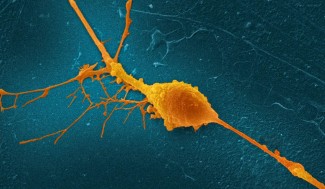Multiple sclerosis is a heterogeneous disease whose manifestations vary considerably from patient to patient and whose course appears, on the surface, unpredictable. Hence, it is crucial to identify the factors that drive disability progression. In a new study published in Brain, researchers at Paris Brain Institute show that spontaneous remyelination of nerve fibres in the cortex has a neuroprotective effect in patients with shorter disease duration and minor lesions: it halves the risk of worsening symptoms five years later. These results will be crucial for targeted patient recruitment in future clinical trials—in which researchers will test drugs that promote myelin repair.
Multiple sclerosis (MS) is an inflammatory disease in which the immune system attacks myelin, the protective sheath of nerve fibres. This abnormality causes brain and spinal cord lesions, which are associated with motor, sensory, or cognitive disorders. In the absence of treatments capable of targeting the causes of MS, researchers at Paris Brain Institute are looking at remyelination—the body's ability to spontaneously regenerate the myelin sheath—and its effects on the course of the disease.
“We are studying remyelination in the cerebral cortex—also known as grey matter—which includes the cell bodies of neurons. Indeed, several studies indicate that remyelination is more extensive and complete in the cortex than in the white matter, made up of axons,” Prof. Benedetta Bodini (AP-HP), neurologist and co-author of the study, explains. “We place high hopes in the study of this biological process. But when we compare the level of cortical remyelination in different patients or evaluate the efficacy of molecules likely to promote myelin repair, we run into a major problem: it's very difficult to see myelin with conventional MRI.”
Innovative use of imaging
To overcome this problem, the team uses magnetization transfer imaging (MTI).
This technique is not new, but until today, it was mainly used to observe white matter — a brain region where the signal is blurred by other processes, such as inflammation. We are the first to use MTI to study cortical remyelination! In this context, the technique makes it possible to quantify myelin very precisely and to monitor the evolution of lesions in each patient
Armed with this new tool, Prof. Benedetta Bodini and her colleague Andrea Lazzaratto (AP-HP, Sorbonne University), the study's first author, set an ambitious goal: to identify the conditions under which myelin was likely to degenerate or rebuild.
“One of the major challenges of this research is that patients are very different. Even when they have the same form of MS and the same number of lesions, one will have a moderate disability. In contrast, the other will experience very severe symptoms that progress rapidly. In short, the number and size of lesions cannot be used to deduce a patient's disability, and vice versa. To try and better explain these differences, we examined their remyelination dynamics over the long term,” Andrea Lazzarotto says.
The effects of remyelination in question
The team, in collaboration with the European MAGNIMS network, recruited 140 patients with multiple sclerosis (37 with a clinically isolated syndrome, 71 with a relapsing-remitting form, 32 with a progressive form) and 84 healthy people in four European neurological centres — Graz, Milan, Paris and Siena. Each participant received a clinical assessment at the start of the study and after five years. An imaging examination was also performed at baseline and after one year.
The researchers' results show that cortical remyelination occurred spontaneously in half the patients, regardless of age, duration of disease or form of MS they had. Most importantly, in patients with short disease duration and limited cortical lesions, significant remyelination was associated with low neurodegeneration after one year and half the risk of disability worsening after five years. Conversely, patients who did not remyelinate much were less well after five years, even without having experienced an inflammatory relapse characteristic of the disease.
These new data indicate that cortical remyelination has a neuroprotective effect and is a key mechanism in contributing to clinical disability. Even if it is not an optimal biological process — new myelin is not always as tough as the original one — it is likely sufficient to protect axons, to the point of delaying the progression of the disease.
According to the researchers, magnetization transfer imaging could be used in future clinical trials to select patients who could best benefit from remyelinating drugs. In addition, MTI is easier to use and less expensive than positron emission tomography (PET) for quantifying myelin.
“The day we have an effective and safe remyelinating treatment, we will know that it is necessary to use it from the very first symptoms, at the same time as immunomodulating or immunosuppressive drugs,” Prof. Benedetta Bodini concludes. “Time is myelin! In eligible patients, the benefits might be very significant.”
Sources
Lazzarotto, A. et al. Time is myelin: early cortical myelin repair prevents atrophy and clinical progression in multiple sclerosis. Brain, Mars 2024. DOI : 10.1093/brain/awae024.







